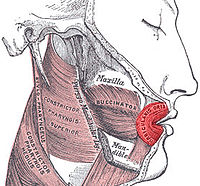
Photo from wikipedia
BACKGROUND The orbicularis oris muscle is extremely important to performing various oral functions, including mastication, swallowing, and speech. Infrared thermography is a non-invasive painless technique that does not require either… Click to show full abstract
BACKGROUND The orbicularis oris muscle is extremely important to performing various oral functions, including mastication, swallowing, and speech. Infrared thermography is a non-invasive painless technique that does not require either contrast or ionization. It has been increasingly used in speech-language-hearing therapy in the last years. OBJECTIVE To propose a thermographic analysis method for the orbicularis oris muscle. METHODS This is an observational, analytical, cross-sectional study. The area of the orbicularis oris muscle was defined based on its anatomy with thermographic images of 11 children and 13 adults. Then, this area was divided into four quadrants, each of which was analyzed considering four different shapes: a triangle; a rectangle; a triangle with a rounded side, including the vermilion zone; and a customized shape encompassing only the region of the orbicularis oris muscle, not including the vermilion zone. Data were collected and analyzed with the coefficient of variation and interrater agreement. RESULTS Data variability for the four shapes had similar dispersions per region of the orbicularis oris muscle, in both maximum and mean temperatures and in both children and adults. The rectangle was the shape with the lowest coefficient of variation in more regions of both adults and children. Interrater agreement was excellent for all shapes, in both children and adults. CONCLUSION Currently, the best way to analyze the orbicularis oris muscle's quadrants is to use the maximum temperature and the rectangle, based on an initial ellipsis encompassing the whole muscle.
Journal Title: Journal of oral rehabilitation
Year Published: 2022
Link to full text (if available)
Share on Social Media: Sign Up to like & get
recommendations!